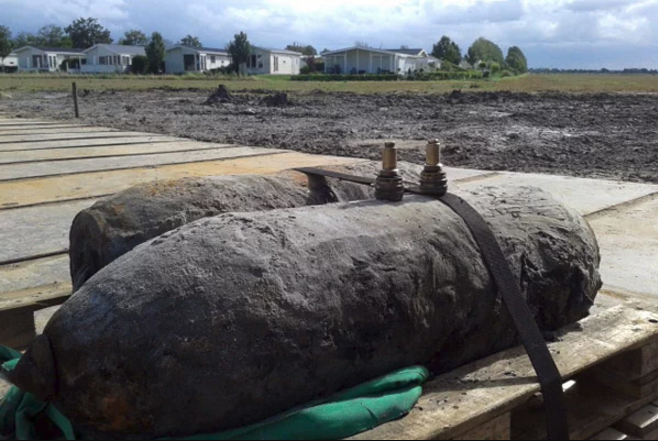Vliegtuigbom WOII in de Maas bij Venlo wordt 24 september 2017 geruimd
In de Maas, ter hoogte van Hout-Blerick en Tegelen tussen de Romeinenweg en Watermunt, is door ECG een niet-gesprongen explosief ontdekt.
Het gaat om een zogenoemde 500-ponder, een vliegtuigbom uit de Tweede Wereldoorlog. De vliegtuigbom ligt zo’n 5 m onder de waterlijn en is woensdag 31 mei 2017 ontdekt tijdens werkzaamheden om de vaargeul van de Maas bij Venlo te verruimen. De Explosieven opruimingsdienst defensie (EODD) ontmantelt de bom op zondag 24 september 2017.
Het explosief zorgt vooralsnog niet voor gevaar of hinder. De bom heeft al 73 jaar op de bodem van de Maas gelegen en ligt daar veilig. In overleg met de gemeente Venlo is in eerste aanleg besloten om het explosief voorlopig ongemoeid te laten en te markeren met een markeringsboei. De scheepvaart kan door. Op de dag dat het explosief wordt geruimd, is een korte stremming voor de scheepvaart van kracht.
De hinder voor omwonenden is beperkt. Mede omdat het water dempend werkt, hoeven er geen mensen te worden geëvacueerd. Alleen zullen de bewoners van ongeveer 50 woningen enige tijd binnen moeten blijven omdat hun huis binnen de straal van 252 m van de veiligheidszone staat. Verder is het werkgebied uiteraard niet toegankelijk.
Demontage
Zondagochtend 24 september om 08.00 uur worden het vlieg- en vaarverkeer stilgelegd. Een half uur later gaat de veiligheidszone dicht; de politie bewaakt het gebied. Om 09.00 uur start dan de demontage. Hoe lang dit gaat duren is niet met zekerheid te zeggen. Is de ontsteker verwijderd, dan zal het sein veilig worden gegeven en wordt het gebied weer vrijgegeven. De bom wordt vervolgens per werkschip naar de Ankerkade vervoerd (haven van Blerick). Van daar gaat de lading per vrachtwagen naar de springlocatie aan de Newtonweg, in de oksel van knooppunt Zaarderheiken, waar de bom op veilige wijze tot ontploffing wordt gebracht.
Explosieven uit de Tweede Wereldoorlog
In en rond Venlo worden regelmatig explosieven uit de Tweede Wereldoorlog gevonden. Uit onderzoek blijkt dat op de bodem van de Maas ook zulke conventionele explosieven (CE) aanwezig zijn. Zowel Rijkswaterstaat als de aannemer gaan hier tijdens de werkzaamheden aan de vaargeul van de Maas zorgvuldig mee om. Hiervoor is ook een Projectplan CE opgesteld dat goedgekeurd is door gemeenten Venlo en Peel en Maas. Bij de vondst van het explosief is het protocol uit het projectplan goed opgevolgd. De omgeving is nooit in gevaar geweest.
Verruiming vaargeul Maas
De vaargeul van de Maas bij Venlo wordt op diepte gebracht en verbreed zodat grotere schepen elkaar onbelemmerd kunnen kruisen of passeren. De werkzaamheden zijn gestart in mei, de volledige opdracht is eind 2018 afgerond. Het detectieonderzoek naar explosieven was al in februari gestart.
Bron: www.rijkswaterstaat.nl (dd. 15 september 2017)
Foto: Koninklijke Landmacht (archieffoto)
